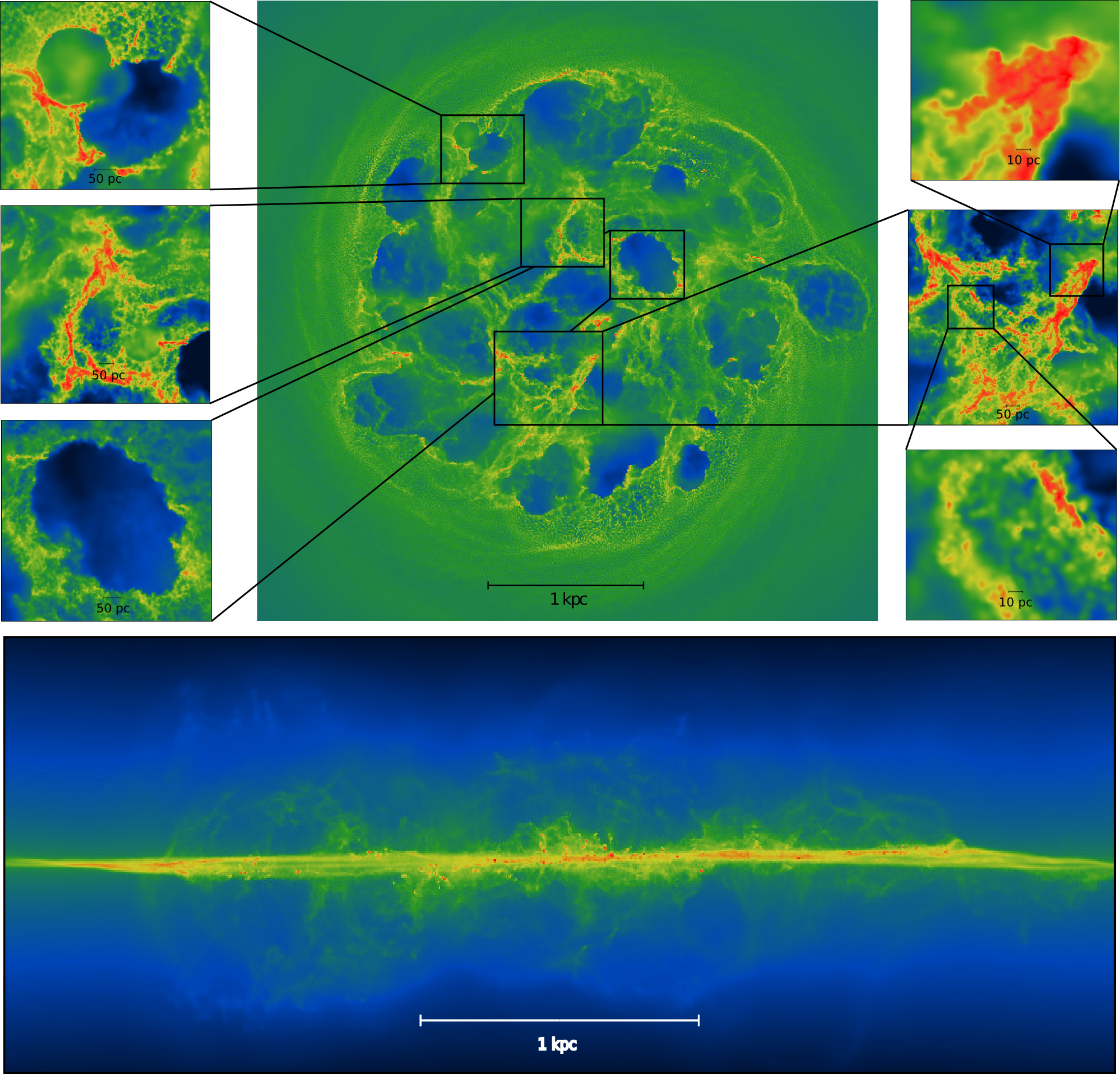Pictures & Movies

Gas distribution of a 108 M☉ dwarf galaxy (stellar and dark matter distributions are not shown) simulated with 4 M☉ gas phase elements and 0.1 pc resolution with the MFM code version (Steinwandel et al. 2019) including non-equilibrium chemistry, Strömgren photoionization and SNe from individual massive stars (see e.g. Hu et al. 2019). Red, green, and blue regions highlight molecular, neutral and ionized hydrogen, respectively. One can clearly see single and overlapping SN bubbles molecular filaments and cloud complexes as well as vertical filamentary outflow.

Large scale stellar and gas surface density, temperature and pressure maps of a gas rich dwarf galaxy merger in a starburst phase, highlighting the dynamic fidelity of the simulation code. Massive star clusters made of individual stars sampled above 4 M☉ drive a super-bubble (Lahén et al. 2019).
Movie of the dwarf merger simulation highlighting the dynamic fidelity of the simulation code. Massive star clusters made of individual stars sampled above 4 M☉ drive strong outflows (Lahén et al. 2019, 2020).
Hierarchical formation of a proto globular cluster (upper left) from high density gas (upper right) with low temperatures (bottom left) and high pressures (bottom right). The massive star clusters is made of individual stars sampled above 4 M☉ and has globular cluster properties (Lahén et al. 2019).
The evolution of the stellar and gaseous surface density (top left and right), the gas temperature (bottom left) and the thermal gas pressure (bottom right) in a hydrodynamical simulation of a low-metallicity (1% of solar) dwarf galaxy (Lahén et al. 2024). The four left panels show a simulation that utilises the gravitational dynamics module KETJU (Rantala et al. 2017, Mannerkoski et al. 2023) to accurately integrate stellar gravitational interactions that occur in the vicinity of stars that are initially more massive than 3 Msun. The four right panels show a simulation that is otherwise identical, but all gravitational interactions have been softened on scales below 0.1 pc. On the left, star clusters are efficiently disrupted due to strong two and few-body interactions that lead to the segregation of massive stars toward the central region, dynamical binary star formation, and expansion of the clusters as they evolve in the tidal field of the host galaxy. Cluster mass-loss is seen as leading and trailing tidal tails that extend from the concentrations of stellar mass. Clusters on the right remain compact and only lose a little mass even over significant periods of time because all close-range interactions are suppressed. The field of view is here 2 kpc and the image resolution is 4 pc per pixel.
A comparison of the evolution of a star cluster with initial mass of ~750 Msun, selected from two star-by-star hydrodynamical dwarf galaxy simulations that are otherwise identical but differ in how stellar gravitational interactions are integrated (Lahén et al. 2024). The top row shows a simulation that uses gravitational softening in all gravitational interactions. The bottom row utilises the gravitational integration module KETJU (Rantala et al. 2017, Mannerkoski et al. 2023) to accurately solve all stellar gravitational interactions in the vicinity of stars that are initially more massive than 3 Msun. The left panel shows the cluster and its environment, the middle panel shows the cluster orbit within the galaxy, and the right panel shows a zoom into the central 3pc within the centre of mass of the cluster. The clusters evolve drastically differently depending on how accurately the interactions of the stars are treated. The cluster that is evolved with gravitational softening remains compact and retains most of the massive stars that formed in the cluster. All stars more massive than 3 Msun are indicated as being either alive (blue stars) or dead (red stars) in each panel. On the other hand, the cluster in which most of the gravitational interactions are solved accurately expands rapidly after its birth, and many of the massive stars escape while they are still alive. This means that the supernovae that occur at the end of the lifetime of these stars will happen in the interstellar medium outside of the birth-cluster. The latter is in agreement with observations of massive stars in the Magellanic clouds, where most of the field O/B-type stars have been interpreted as being ejected dynamically from clusters.